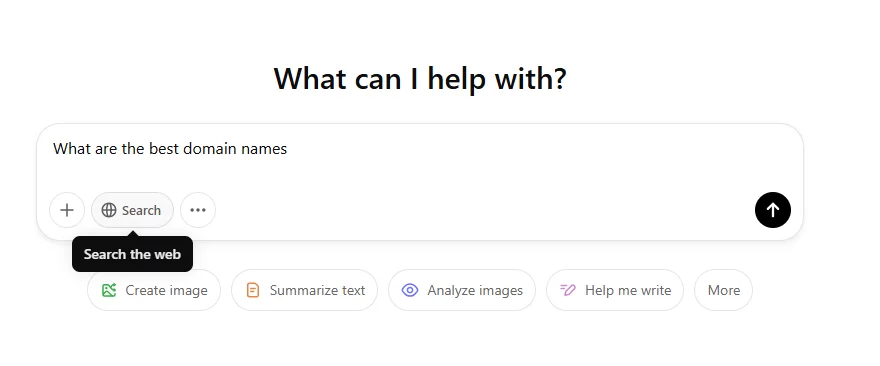How to Optimize Your Website for ChatGPT Search
- by Ilona K.

Table of contents
From February 2025, ChatGPT search, the new function of ChatGPT generative AI bot, is available to everyone in regions where the platform is accessible, and there’s no need to sign up. For website owners, it’s a great opportunity to drive traffic and attract new audiences. Learn how to make sure your website gets noticed by ChatGPT search.
What is ChatGPT Search?
ChatGPT Search works by combining OpenAI’s language model with real-time web browsing capabilities. When users ask questions, ChatGPT pulls relevant information from search engines and websites that allow access, presenting concise answers in a conversational format. It doesn’t crawl websites directly but relies on search engine indexing and website accessibility to find the best responses.

The importance of optimizing your website for ChatGPT Search is growing, as AI-driven platforms are becoming significant traffic sources. A recent study found that 63% of websites receive traffic from AI chatbots, with ChatGPT accounting for 50% of this AI-driven traffic. Specifically in search, ChatGPT is expected to gain 1% share of the search market by next year, according to a prediction by Brightedge. In comparison, Bing now occupies 3.9% of the market.
Additionally, Adobe reported a tenfold increase in traffic from generative AI sources to online retailers between July and September 2024, indicating a substantial shift in consumer behavior towards AI-assisted shopping.
By ensuring your content is accessible and optimized for AI platforms, you can tap into this growing stream of visitors and stay ahead in the evolving digital landscape.

How to Get Featured in ChatGPT Search
1. Make sure your content gets indexed
If search engines can’t find your content, neither can ChatGPT. Here’s how to make sure your pages get indexed:
- submit your sitemap using Google Search Console and Bing Webmaster Tools
- add structured data with tools like Schema.org to help search engines understand your content
- check for crawl errors in Google Search Console to see if search engines are having trouble accessing your site
2. Let GPTbot access your site
OpenAI’s GPTBot helps improve AI models like ChatGPT by crawling the web. If you want your content to be included, you’ll need to allow access to its bot.
How to allow access
Add these lines to your robots.txt file:
User-agent: GPTBot
Allow: /
How to block certain content
If you don’t want GPTBot accessing specific parts of your site, adjust your robots.txt like this:
User-agent: GPTBot
Disallow: /private/
You can also monitor GPTBot activity through your server logs. This helps ensure it’s crawling the right content.
3. Optimize your site for traditional SEO
While ChatGPT doesn’t crawl websites directly, it relies heavily on search engines like Google and Bing to pull information. That means strong SEO practices are still your best bet for visibility.
- target relevant keywords using tools like Google Keyword Planner or Ahrefs
- write helpful content like blog posts, guides, and FAQs that answer common questions
- speed up your site by checking performance with Google PageSpeed Insights
- make sure your site works well on mobile devices
4. Write like you’re talking to someone
Since ChatGPT generates conversational answers, your content should sound natural and approachable.
- answer common questions using headings like “what is…?” and “how to…?”
- create an FAQ page that’s easy to navigate (and use FAQ structured data to mark up the questions and answers)
- keep your tone friendly and conversational where possible
5. Build authority and get backlinks
ChatGPT tends to pull from trusted sources. Here’s how to boost your site’s credibility:
- earn quality backlinks by writing guest posts, participating in forums, and getting reputable sites to link to your content
- follow Google’s E-E-A-T guidelines (experience, expertise, authoritativeness, and trustworthiness)
- keep your content fresh by updating blog posts and guides regularly
6. Add an /llms.txt file to your site
To make your website more accessible to large language models (LLMs) like ChatGPT, add an /llms.txt file in your root directory. This file acts like a sitemap for AI, guiding them to your most important content.
Here’s a simple example:
# my website
> a site for business tips and insights
## key sections
– [blog](https://yourwebsite.com/blog): insights and advice
– [products](https://yourwebsite.com/products): our offerings
7. Monitor AI-driven traffic
While ChatGPT itself doesn’t show as a traffic source, you can still track AI-driven visitors in Google Analytics:
- create a custom segment to identify traffic from AI-related referrer sources
- check referrer paths under “acquisition” > “all traffic” > “referrals”
- add UTM parameters to urls when sharing content you want ChatGPT to pick up
- watch landing pages to see which content is attracting AI-driven traffic
You can use a handy Google Looker Studio template to track traffic from ChatGPT and other AI sources – simply duplicate it and connect to your Google Analytics.
Keen to succeed online? Visit it.com Domains blog and follow us on social media.

Read also

Tips and Tricks
AI Appreciation Day: Top-10 Domain Names for AI Startups on it.com Domains
- 3 min read

